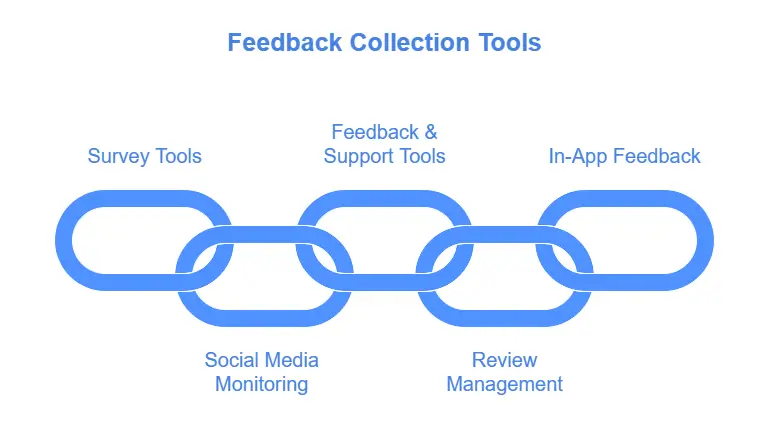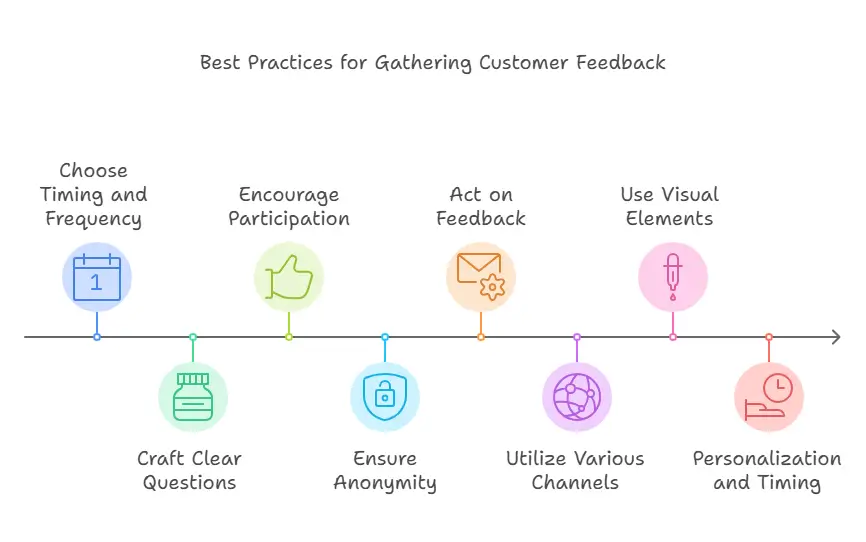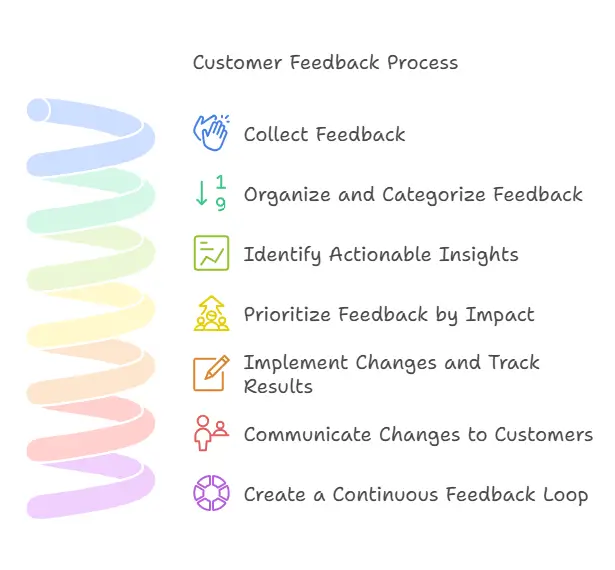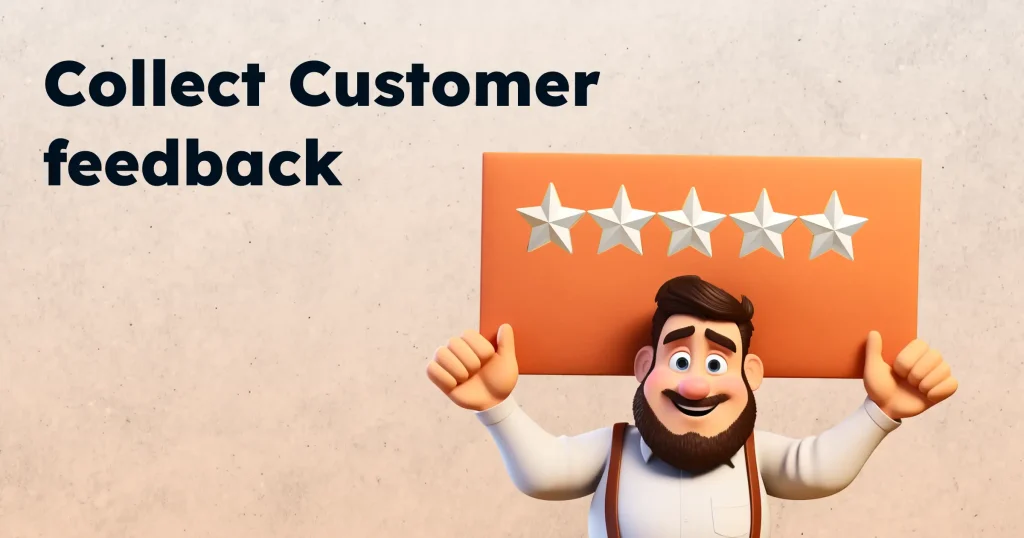Collecting customer feedback isn’t just about finding out what’s working. It’s about discovering how to improve and keep customers satisfied. For small and medium-sized businesses (SMBs), know how to collect feedback effectively can mean the difference between customer loyalty and losing customers to competitors. This guide will show you ways to collect customer feedback, including low-cost and practical methods that are easy to implement.
In this article, you’ll find the best methods to gather valuable insights from your customers, from customer feedback surveys to using social media channels. We’ll also cover tools to collect customer feedback and how to turn customer opinions into actionable feedback.
How to Collect Feedback from Customers: Understanding Customer Feedback
Customer feedback is the information, insights, and reactions that customers share about their experiences with a business’s products or services. It includes both positive feedback (what they love) and negative feedback (areas for improvement). Addressing the concerns of unhappy customers and utilizing their feedback for improvement is crucial. Collecting this feedback is essential because it helps highlights pain points, and provides valuable insights into how to better meet customer expectations.
What is Customer Feedback?
Customer feedback is the information and opinions provided by customers about their experiences, perceptions, and expectations with a product, service, or brand. It encompasses a wide range of insights, including satisfaction levels, areas of improvement, preferences, and expectations. Customer feedback can be collected through various channels such as surveys, reviews, social media interactions, and direct conversations. This feedback is invaluable for businesses as it offers a direct line to understanding customer needs and expectations, helping to shape better products and services.
Definition and Importance
Customer feedback is the information and opinions provided by customers about their experiences, perceptions, and expectations with a product, service, or brand. It is crucial for businesses to collect customer feedback as it helps to identify areas of improvement, increase customer loyalty, drive business growth, and stay competitive in the market. By collecting customer feedback, businesses can gain valuable insights into customer needs, preferences, which can inform product development, marketing strategies, and customer service improvements.
Why is Collecting Customer Feedback Important for SMBs?
For SMBs, collecting customer feedback is a direct path to understanding what drives customer loyalty and how to improve the customer experience. Addressing feedback from unhappy customers is crucial for improving customer loyalty and retention. When SMBs make an effort to gather customer feedback, they gain insights that fuel growth and help create a customer feedback strategy. Here are some key reasons why feedback collection matters:
- Identify Areas for Improvement: Negative feedback reveals customer issues, enabling businesses to address specific issues in the customer journey.
- Enhance Customer Loyalty: Listening and responding to feedback shows customers that their opinions are valued, which can build customer loyalty.
- Understand Customer Preferences: Feedback helps SMBs tune in to customer needs and preferences, guiding product and service improvements.
- Increase Customer Retention: By using actionable insights from feedback, businesses can adapt to keep customers satisfied and encourage repeat purchases.
Methods for Collecting Customer Feedback

1. Customer Feedback Surveys
Surveys are one of the most popular and effective ways to collect customer feedback. They allow businesses to ask targeted questions and gain detailed feedback on specific aspects of the customer experience. Surveys can also help identify and address the concerns of unhappy customers. Here are some common survey methods:
- Email Surveys: Send a short survey after a purchase or interaction to gauge customer satisfaction. These can include customer satisfaction scores and open-ended questions for qualitative feedback.
- In-App or Website Surveys: Place surveys directly within an app or website, enabling instant feedback on user satisfaction, functionality, or usability.
- CSAT: These measure how satisfied customers are with a particular interaction or the product overall.
- Net Promoter Score (NPS): NPS surveys measure customer loyalty by asking how likely they are to recommend your business to others.
2. Customer Interviews
Interviews provide deeper insights by allowing you to talk directly to customers and understand their needs and expectations. While they take more time than surveys, customer interviews can yield valuable insights that are hard to capture through other methods. Try conducting short interviews with loyal customers or those who have given recent feedback.
3. Focus Groups
Focus groups gather small groups of customers to discuss specific aspects of a product, service, or experience. By facilitating a group discussion, you can gather both qualitative feedback and customer opinions. This method is ideal for gaining consumer feedback on new products or upcoming features.
4. Social Media Listening
Many customers share their thoughts on social media channels like Facebook, Twitter, and Instagram. By monitoring these platforms, you can collect direct feedback and respond in real time. Tools like Hootsuite or Sprout Social can help track mentions of your brand, making it easier to respond to customer service interactions and improve the customer journey.
5. Online Reviews and Ratings
Online reviews provide a rich source of customer feedback. They can help identify issues faced by unhappy customers and provide opportunities to address them. Platforms like Google Reviews, Yelp, and industry-specific sites are great for gathering honest feedback. Reviews not only highlight what customers like but also provide actionable insights into areas for improvement. Regularly monitoring and responding to reviews shows customers that you value their input and are committed to improving.
6. Feedback Forms
Feedback forms on your website or in emails allow customers to submit feedback at any time. Whether through a simple form or feedback boxes on specific pages, these forms enable quick feedback and are especially useful for tracking customer satisfaction over time.
7. Product or Service Usage Analytics
While not direct feedback, analyzing how customers interact with your product or service can reveal important trends. For instance, if customers frequently stop using a feature, this may indicate a pain point or area for improvement. Tracking metrics through analytics can complement other feedback methods.
8. Transactional Emails and Live Chat Data
Transactional emails and live chat data are two effective ways to collect customer feedback. Transactional emails can be used to gather feedback from customers at specific touchpoints, such as after a purchase or when a customer abandons their cart. Live chat data, on the other hand, provides real-time insights into customer interactions and can be used to identify areas for improvement in customer service. By analyzing transactional emails and live chat data, businesses can gain a deeper understanding of customer behavior and preferences, and make data-driven decisions to improve the customer experience.
Tools and Platforms for Feedback Collection

1. Survey Tools
For small and medium-sized businesses, survey tools offer an affordable and efficient way to gather customer feedback. Many survey platforms provide templates, analytics, and integration with other tools, making feedback collection manageable even for lean teams. Here are some popular options:
- Google Forms: Free and easy to set up, Google Forms is ideal for quick surveys. Responses are automatically organized, and data can be easily exported for further analysis.
- SurveyMonkey: Known for its customizable templates, SurveyMonkey is a reliable choice for creating detailed surveys that can measure customer satisfaction, collect feature requests, or gain customer insights.
- Typeform: Typeform’s interactive and visually appealing survey forms are engaging for customers, increasing the likelihood of responses.
2. Social Media Monitoring Tools
Social media listening tools allow businesses to monitor and collect feedback from various social media channels. They’re especially useful for tracking brand mentions, sentiment, and public responses in real-time. Popular tools include:
- Hootsuite: This tool helps SMBs track customer feedback and customer service interactions across multiple social platforms, providing valuable customer opinions.
- Sprout Social: Sprout Social offers detailed analytics and monitoring, making it easy to gather customer insights and address feedback.
- Mention: With a focus on tracking brand mentions and keywords, Mention allows businesses to stay aware of online conversations relevant to their brand.
3. Customer Feedback and Support Tools
Some tools are specifically designed to manage and collect customer feedback while also supporting customer service needs. These tools provide a range of options, from tracking customer satisfaction ratings to collecting instant feedback during interactions:
- Zendesk: A comprehensive customer support tool, Zendesk offers built-in features to collect feedback during and after customer interactions, helping SMBs improve their customer support.
- Intercom: Intercom combines customer support with feedback collection, allowing businesses to request feedback after chat sessions and support tickets.
- Desku: Desku’s suite includes feedback surveys that measure customer loyalty and building customer loyalty while integrating with other CRM functions.
4. Review and Reputation Management Tools
These tools aggregate online reviews and ratings, providing an overview of customer sentiment and specific feedback across platforms:
- Trustpilot: Trustpilot helps SMBs collect and respond to customer reviews, making it easier to understand customer expectations and improve customer service.
- Yotpo: Yotpo specializes in collecting reviews and ratings, providing detailed analytics on customer behaviour and helping to identify loyal customers.
- Birdeye: With features that track and manage reviews across multiple sites, Birdeye allows businesses to gain a clear view of customer opinions and respond effectively.
5. In-App Feedback Tools
For SMBs with digital products or apps, in-app feedback tools are essential for collecting relevant feedback directly from users. These tools capture insights at the point of use, offering instant access to customer preferences and pain points:
- Qualaroo: This tool places feedback prompts directly within your app or website, encouraging users to provide detailed feedback on their experience.
- Usabilla: Known for its easy-to-use feedback forms, Usabilla collects feedback from website visitors, allowing for quick feedback and insights on user behavior.
- Hotjar: Hotjar combines feedback and behavior analytics, capturing both qualitative and quantitative data for a deeper understanding of customer behavior.
Best Practices for Gathering Feedback

Collecting customer feedback is more than just setting up surveys or using tools; it’s about using the right approach to gather honest, actionable feedback. Here are some best practices for small and medium-sized businesses (SMBs) looking to make the most of their feedback collection efforts.
1. Choose the Right Timing and Frequency
When you ask for feedback matters. Avoid overwhelming customers by requesting feedback too frequently, but don’t wait so long that the experience fades from memory. Here are some timing strategies:
- Post-Purchase or Post-Interaction: Send a quick survey immediately after a purchase or customer support interaction for the most relevant feedback.
- Periodic Surveys: For more general feedback, send out quarterly or biannual surveys to understand more about customer.
- Trigger-Based Feedback: Use specific actions (like cart abandonment or site exit) to trigger feedback forms that capture instant feedback on customer experiences.
2. Craft Clear and Relevant Questions
The questions you ask should focus on getting detailed feedback that’s easy to act upon. Here are some question tips:
- Keep Questions Simple: Avoid complex language. Clear, direct questions increase response rates.
- Include a Mix of Open and Closed Questions: Closed questions (yes/no, rating scales) provide quick insights, while open-ended questions gather valuable insights into customer thoughts and preferences.
- Focus on Specifics: Instead of “How was your experience?”, ask “How satisfied were you with the checkout process?” for more focused feedback on particular parts of the customer journey.
3. Encourage Customer Participation
It’s essential to motivate customers to share their thoughts. Consider these tactics:
- Incentivize Feedback: Offering a small incentive (like a discount or entry into a prize draw) can increase participation rates.
- Personalize Your Request: Personalized emails that address the customer by name and reference their specific interactions can increase response rates.
- Simplify the Process: Make feedback forms easy to complete with minimal steps. If forms are too long or complicated, customers may abandon them.
4. Ensure Anonymity and Confidentiality
Many customers hesitate to share honest feedback if they feel their answers aren’t private. Let them know that their responses are anonymous, if possible, or reassure them that their feedback will be handled confidentially. This assurance can result in more open and valuable feedback.
5. Act on the Feedback You Receive
Collecting feedback without acting on it can frustrate customers and reduce future participation. Once feedback is collected:
- Analyze for Actionable Insights: Identify common themes or recurring pain points that reveal customer needs.
- Implement Changes Based on Feedback: Make adjustments or improvements based on the feedback, whether it’s refining a product feature or improving customer support.
- Close the Loop with Customers: Let customers know when changes have been made based on their input. For instance, send an email saying, “You asked, and we listened!” to demonstrate that their feedback is valued.
6. Utilize Various Channels
Utilizing various channels is essential for collecting customer feedback. Businesses should leverage multiple channels such as email, website, and in-app to reach a wider audience and gather diverse feedback. This can include using survey software, feedback widgets, and social media listening tools to collect feedback from customers. By using multiple channels, businesses can increase the response rate and gather more actionable insights from customers.
7. Use Visual Elements to Engage Customers
Using visual elements is an effective way to engage customers and collect feedback. Visual elements such as icons, images, and videos can be used to make feedback forms more engaging and user-friendly. Businesses can also use visual elements to make feedback more interactive, such as using gamification or interactive surveys. By using visual elements, businesses can increase customer engagement and encourage customers to provide more detailed and actionable feedback.
8. Personalization and Timing
Personalization and timing are crucial when it comes to collecting customer feedback. By tailoring the feedback experience to individual customers based on their past interactions and preferences, businesses can significantly increase the likelihood of participation. For instance, addressing customers by their names and referencing their specific purchases or interactions can make the feedback request feel more relevant and personal.
Timing also plays a significant role in collecting valuable feedback. Requesting feedback at the right moment, such as immediately after a purchase or a customer service interaction, can provide more accurate and actionable insights. This approach ensures that the experience is fresh in the customer’s mind, leading to more detailed and relevant feedback. By focusing on personalization and timing, businesses can gather more meaningful and valuable feedback that can drive improvements and enhance the overall customer experience.
Analyzing and Acting on Customer Feedback

Collecting feedback is only the first step. Analyzing customer feedback and taking informed actions is what brings real value to your business. Here’s how SMBs can make the most out of the feedback they gather.
1. Organize and Categorize Feedback
To make feedback actionable, organize it by themes, such as product features, customer service interactions, or usability issues. Many tools automatically categorize feedback, but even a simple spreadsheet can work for smaller volumes. Common feedback categories might include:
- Product/Service Quality
- Customer Support
- Ease of Use
- Pricing
- Feature Requests
Categorizing helps you identify which areas need immediate attention and which trends to monitor.
2. Identify Actionable Insights
Once feedback is organized, look for patterns and recurring issues. Feedback from unhappy customers can highlight pain points and areas for improvement. For example, if multiple customers mention issues with the checkout process, this highlights an area for improvement. Use this step to pull out actionable insights—specific changes that could enhance the customer experience or solve identified pain points.
3. Prioritize Feedback by Impact
Not all feedback will have the same impact on your business. Prioritize actions based on potential benefits for customer loyalty. For instance, a small fix for a frequently mentioned issue may yield significant improvements in user satisfaction, while a more complex change might be beneficial but not immediately necessary.
4. Implement Changes and Track Results
Make adjustments based on the feedback, then track the outcomes. For example, if customers request shorter response times from customer support, implement quicker response measures and monitor CSAT ratings before and after the change. Tracking results helps assess whether the change effectively addressed the issue.
5. Communicate Changes to Customers
Letting customers know their feedback has led to positive changes encourages them to share more insights in the future. Here’s how you can keep customers informed:
- Send a Follow-Up Email: Inform customers about updates made in response to their feedback. For instance, “We’ve improved our checkout process based on your feedback. Let us know what you think!”
- Share Updates Publicly: Post updates on social media or in newsletters highlighting key improvements. This shows both new and existing customers that you value their customer feedback.
6. Create a Continuous Feedback Loop
Make feedback collection and implementation an ongoing process. By consistently gathering feedback, analyzing insights, and acting on feedback, your business stays attuned to customer needs and expectations. This ongoing process helps build customer loyalty and ensures you’re always working toward a better customer experience.
7. Using Customer Feedback to Improve Products and Services
Using customer feedback to improve products and services is essential for businesses to stay competitive and meet customer expectations. By thoroughly analyzing customer feedback, businesses can pinpoint specific areas that need enhancement, thereby boosting customer satisfaction and loyalty. For example, feedback highlighting a common issue with a product feature can lead to targeted improvements that directly address customer concerns.
Customer feedback is also instrumental in informing product development. Insights gathered from customers can guide the creation of new features or the refinement of existing ones, ensuring that the product evolves in line with customer needs. Additionally, feedback can help optimize the customer journey by identifying pain points and areas where the customer experience can be streamlined.
Incorporating customer feedback into the decision-making process fosters a customer-centric approach, driving growth and success. By continuously listening to and acting on customer feedback, businesses can create products and services that not only meet but exceed customer expectations, leading to increased customer loyalty and long-term success.
Implementing Customer Feedback
Implementing customer feedback is crucial for businesses to improve the customer experience and drive business growth. Here are some ways to implement customer feedback:
1. Feed Customer Feedback into Your Product Roadmap
Feeding customer feedback into your product roadmap is essential for businesses to prioritize product development and make data-driven decisions. By analyzing customer feedback, businesses can identify areas for improvement and prioritize product features and updates. This can help businesses to create products that meet customer needs and expectations, and drive business growth. By feeding customer feedback into your product roadmap, businesses can ensure that customer needs are at the forefront of product development and that the product roadmap is aligned with customer expectations.
Case Studies – Success Stories of SMBs Using Customer Feedback
Case studies offer real-life examples of how businesses have successfully used customer feedback to make meaningful changes.
1. Local Café Enhances Customer Experience Based on Feedback
A small, family-owned café regularly gathered feedback through feedback forms placed at each table and on their website. Customers shared both positive feedback about the menu and negative feedback on long wait times during peak hours. After analyzing the feedback, the café adjusted its staffing during busy periods and streamlined the ordering process.
Result: This small change led to a CSAT score and an increase in repeat customers who appreciated the faster service. The café also noticed an improvement in their customer loyalty as regular patrons responded positively to the visible changes.
2. Niche Online Retailer Boosts Customer Loyalty with Product Changes
An online retailer specializing in sustainable products began collecting feedback through post-purchase customer surveys. Many customers shared feature requests for more eco-friendly packaging. The retailer quickly implemented this feedback by switching to fully recyclable materials.
Result: Customers responded well, with online reviews reflecting higher satisfaction levels. The retailer gained loyal customers who valued the brand’s commitment to sustainability, as demonstrated through customer feedback-driven changes.
3. Small SaaS Company Increases Retention by Addressing User Pain Points
A SaaS company serving SMBs used in-app surveys and social media channels to gather feedback from users about the software’s interface. Many users mentioned a steep learning curve with the initial setup. Recognizing this as a pain point, the company added an onboarding tutorial and improved customer support for new users.
Result: Customer satisfaction improved, as shown by follow-up surveys, and the company saw a notable decrease in churn rate. Customers appreciated the actionable feedback loop and were more likely to provide feedback in the future.
4. Fitness Studio Adapts Services to Meet Customer Needs
A boutique fitness studio collected feedback from customers through post-class surveys and interviews. Many participants expressed a desire for more flexible class times. By adjusting their schedule to offer early morning and late evening classes, the studio catered to their customers’ schedules.
Result: The new class times increased attendance and brought in new customers. Positive responses about the schedule changes also boosted customer retention as members felt their preferences were heard and addressed.
Conclusion
Collecting customer feedback is essential for small and medium-sized businesses to improve their products, services, and overall customer experience. By implementing a well-rounded customer feedback strategy, SMBs can identify pain points, understand customer needs, and make changes that customer loyalty.
From using customer feedback surveys and social media listening to analyzing actionable insights and adjusting based on detailed feedback, there are numerous ways to make customer voices a core part of business growth. Effective feedback collection is not just about gathering opinions—it’s about showing customers that their input is valued and acted upon. By creating an ongoing feedback loop, SMBs can continuously adapt to meet customer expectations and build lasting relationships with their audience.
Ready to start gathering feedback? Choose a few methods from this guide, implement best practices, and let your customers help guide your next steps!
FAQs
Why is collecting customer feedback important for small and medium-sized businesses (SMBs)?
Collecting customer feedback helps SMBs identify areas for improvement, understand customer preferences, and build loyalty. It provides actionable insights that can lead to enhanced customer satisfaction, improved products or services, and increased customer retention.
What are some low-cost methods to collect customer feedback?
Low-cost methods include customer feedback surveys (e.g., email or in-app), monitoring social media channels, using feedback forms on websites, and analyzing online reviews. These methods are practical, easy to implement, and effective for gathering insights.
How can SMBs ensure they act on the feedback they receive?
To act on feedback, SMBs should organize it into categories, prioritize based on impact, and implement changes. It’s also important to communicate these changes to customers, showing them that their input is valued and contributes to business improvements.
What tools can SMBs use to collect and analyze customer feedback?
SMBs can use tools like Google Forms, SurveyMonkey, Hootsuite, and Zendesk to collect and analyze feedback. These tools offer features such as customizable surveys, social media monitoring, and feedback tracking, making it easier to gather and act on customer insights.
How can businesses encourage customers to provide feedback?
Businesses can encourage feedback by simplifying the process, offering incentives like discounts or entries into a prize draw, and personalizing feedback requests. Ensuring anonymity and confidentiality can also make customers more comfortable sharing honest opinions.


